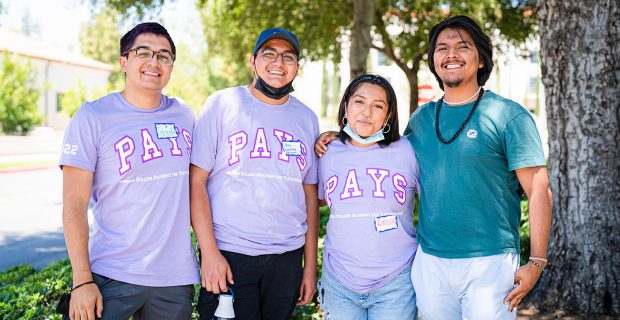As we set out to write about pairs of Pomona people whose lives or work are intertwined in this issue of PCM, we weren’t thinking so much about mentorship. Yet it emerged as a subtext, and not only in cases of an older person guiding a younger one. Sometimes, the roles seemed almost interchangeable, and it struck me that mentoring is a very natural outcome of the Pomona experience.
One of the best examples of Pomona’s mentoring efforts for the community returned to campus this summer for the first time since 2019. The Draper Center’s Pomona College Academy for Youth Success (PAYS)—a multi-year program to prepare area high school students from low-income or traditionally underrepresented backgrounds to enter selective colleges and universities—was back in classrooms and residence halls for the core four-week summer experience after two years online because of the pandemic.

Pomona students serving as PAYS teaching assistants include, from left: Gerardo Hurtado ’24, Jose Sanchez Mara ’24 and Katherine Rivas ’25, who is a PAYS alumna. David Diaz, in green, is a PAYS alumnus attending Swarthmore whose younger brother is now in PAYS.
What unfolds during those campus stays can be astounding. As Biology Professor Sara Olson mentioned while introducing Nobel Prize winner Jennifer Doudna ’85 at the Class of 2022 Commencement in May, the revolutionary gene-editing technology Doudna and Emmanuelle Charpentier pioneered is something even teenagers can learn.
“CRISPR is fast, easy and accessible, allowing even our high school PAYS students to use and understand this technology,” says Olson, who dedicates part of her summers to the program.
The first year Olson incorporated CRISPR was 2019, the last time PAYS was on campus. Students designed edits for a C. elegans worm eggshell project, with each student assigned one gene to delete to explore whether it was important in forming the eggshell. The students designed and created DNA plasmids that would then be injected into the worm to carry out the CRISPR edit. They nearly made it through the plasmid construction stage but didn’t quite make it to the injection stage before the summer session ended.
In 2020, the necessity of being online limited the scope of the work, but students worked to design a theoretical CRISPR-based treatment for COVID-19. “They ended up narrowing in on the same target that some antiviral therapies are now targeting, without even knowing anything about it beforehand,” Olson says.
Among those who worked on that 2020 project was Khadi Diallo ’25, then a student at Ontario’s Colony High and now a rising sophomore at Pomona. She works in Olson’s lab and is a teaching assistant for this year’s PAYS program.
“It’s neat to see her come full circle and be a mentor for them,” Olson says.
It’s the Pomona way. We hope you enjoy the issue.
